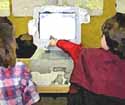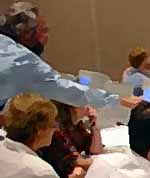The WIRED Classroom (continued)
|
||||||||||||||||||||||||||||||||||||||||||||||||||||||||||||||||||||||||||||||||||||||||||||||||||||||||||||||||||||||||
|
Classroom Connect provides some excellent research projects which are structured with an emphasis upon the Research Cycle http://register.classroom.com/cq.htm Connected Questions - Integrated Units for Internet Research
Each book presents three open-ended questions designed to interest young people. Students complete an interdisciplinary unit, while researching all aspects of a question and developing persuasive arguments for their conclusions. Students are directed to Internet resources which have been checked out in advance for relevance and value. |
When we enter the Wired Classroom, we see intense focus upon task, often as not with teams of students exploring, researching, inventing and creating. The path for learning has been clearly defined with frequent check points and conferencing requiring students to demonstrate both progress and quality. They must meet standards before moving ahead.
 |
Students are usually sharing a screen - leaning and pointing as they seek and then interpret. Most often they will have several programs open at the same time, a browser for gathering and some kind other tool [such as a database or spreadsheet or word processor] for storing and analyzing what they have found. |
Engaged Learning Indicators (Means)*
- Children are engaged in authentic and multi-disciplinary tasks
- Students participate in interactive learning
- Students work collaboratively
- Students learn through exploration
We should expect even more than these indicators from our students. In addition to the activities listed above, we should demand fresh thinking and rigor. We should write and share rubrics [example] which clarify these high expectations. It is not enough to "go through the motions."
In all too many cases we have settled for mere usage of technology as evidence of success. This focus upon activity can no longer suffice. We are not doing technology for technology's sake.
Some of the activities often heralded as models fail the basic test of significance . . .
The report may be full of glitz and glimmer but lacking in content or value.
|
The two fifth grade students were proud to stand up and show off their multimedia report on TIGERS. They had pushed the presentation software to its limits and the class watching the presentation were so enthralled with the fancy transitions and special effects that they never even noticed when the boys substituted a picture of a lion when they were unable to find a picture of a tiger. I suppose they figured they were both cats? |
It is a foolish waste of technology, money and information power to assign information gathering, topical research projects such as the following . . .
- Find out about China, Connecticut, Acid Rain, Mozart, Lincoln, Emily Dickinson, etc.
- What happened at the Battle of Bunker Hill?
Student research should focus upon essential questions . . .
|
Decisions
Problems
|
For further reading about essential questions and the Research Cycle, check out these articles from previous issues of From Now On.
|
|
|
|
|
|
|
|
|
How does the teacher act?
A good teacher knows when to act as "Sage on the Stage" and when to act as "Guide on the Side." Because student-centered learning can be time-consuming and messy, efficiency will sometimes argue for the Sage. When students are busy making up their own minds, the role of the teacher shifts.
When questioning, problem-solving and investigation become the priority classroom activities, the teacher becomes "Guide on the Side."
|
|
|||||||
|
|
|
|
|
||||
|
|
|
|
|
||||
In a recent hands-on workshop [Power Learning at KETC'98] designed to model this type of classroom experience, participants provided the following list of verbs to describe the activities of a teacher who is a "Guide on the Side" while students are conducting their investigations:
| circulating |
|
moderating |
| redirecting |
|
diagnosing |
| disciplining |
|
trouble-shooting |
| questioning |
|
observing |
| assessing |
|
encouraging |
| guiding |
|
suggesting |
| directing |
|
modeling |
| fascinating |
|
clarifying |
 |
The teacher is on the move, checking over shoulders, asking questions and teaching mini-lessons for individuals and groups who need a particular skill. Support is customized and individualized. The "Guide on the Side" sets clear expectations, provides explicit directions, and keeps the learning well structured and productive. |
The title of one chapter, "Coming to Know One's World," is an apt way of thinking about classrooms which place a premium on exploring. The guiding principles of constructivism match the themes of this article:
- Posing problems of emerging relevance to students.
- Structuring learning around primary concepts: the quest for essence.
- Seeking and valuing students' points of view.
- Adapting curriculum to address students' suppositions.
- Assessing student learning in the context of teaching.
(Page 33)
The Brooks offer a list of behaviors which makes a wonderful self-assessment tool for teachers thinking about their constructivist behaviors. The chart below is adapted from their list and simplified for assessment purposes.
Ratings: 4 = most of the time 3 = much of the time 2 = sometimes 1 = rarely
| 1. Encourage student autonomy | |
| 2. Explore raw data and primary sources | |
| 3. Employ terms such as "classify," "analyze," "predict," and "create." | |
| 4. Allow student ideas to help steer learning | |
| 5. Give students a chance to speak their own minds about concepts first | |
| 6. Encourage students to engage in dialogue | |
| 7. Ask open-ended questions and encourage student questions | |
| 8. Seek elaboration of students' initial responses. | |
| 9. Inspire students to revise original thinking and hypotheses in light of experience | |
| 10. Allow wait time after posing questions | |
| 11. Provide time for students to construct relationships and create metaphors | |
| 12. Nurture students' natural curiosity through frequent use of a learning cycle model | |
| In Search of Understanding: the Case for Constructivist Classrooms (pp. 103-117) |
Many teachers will find the journey toward an increasingly student-centered classroom both a challenge and a joy, provided they are fully supported during the learning process with a robust professional development program.
|
|
|
|
|
|
|
|
|
What kinds of structures?
The Wired classroom requires a great deal of structure . . . Scaffolding is the essential ingredient which helps to keep the classroom humming with purposeful, productive learning. The better the framework we supply as teachers, the more successful our students will become.
Framework
- A structure for supporting or enclosing something else, especially a skeletal support used as the basis for something being constructed. [The American Heritage Dictionary of the English Language, Third Edition]
In order to clarify expectations and keep students on task, the teacher outlines the jobs which need to be completed, points students to the resources required and then monitors their performance to make sure they are moving forward deliberately and successfully.
The teacher requires students to show work at frequent check points along the path, conferencing often to supply just the right amount of the guidance so that the students are developing independence and responsibility within reasonable boundaries.
An example of careful structuring for a fifth grade student can be found at this site which outlines a unit of planetary study. http://wwwsil.bham.wednet.edu/1planet.htm
An example of careful structuring for high school students can be found at this site which outlines a unit exploring bioethics and cloning. http://www.gpisd.org/Modules/Highschools/!GPISDMO.DUL/VISIT1.HTM
|
|
|
|
|
|
|
|
|
What kinds of assessments work best?
Expectations are clarified up front.
Students need to see models of the products they are expected to create. If they have a clear picture of what they are trying to produce, they can keep holding their own work up to compare it with the exemplars shown by the teacher. In addition, the better job we do of defining standards through the use of rubrics and other assessment devices, the better students will be able to align their efforts with the task requirements.
Assessments are based on students' performance of real tasks.
We need to focus attention on the tasks which are completed throughout the learning journey, not just the end product. We take the important action verbs and keep asking how students might improve and grow.
|
|
As much as possible we select challenges and issues from the "real world" and ask that students give us their best thinking in response to these issues.
Assessment is ongoing and frequent.
We do not wait until the end of the process to ask how we are doing. We do not focus solely on product. We make assessment ongoing and frequent, changing our strategies and asking students to adjust and modify their efforts as we see what is working and what is not. As teachers we employ our assessment findings to steer our own efforts, directing our attention where it will do the most good and shedding those strategies which are proving inconsequential in favor of those proven beneficial. We employ assessment as a prime tool in support of program development.
Students share responsibility for assessing progress and quality.
As much as possible we foster independent and peer assessment by students. We want them to learn how to shape and improve their own efforts. Self assessment requires a strong grounding in the use of criteria and standards.
- What is it that matters?
- How do we know when we have achieved quality?
- How will we improve?
- How will we reach excellence?
|
|
|
|
|
|
|
|
|
